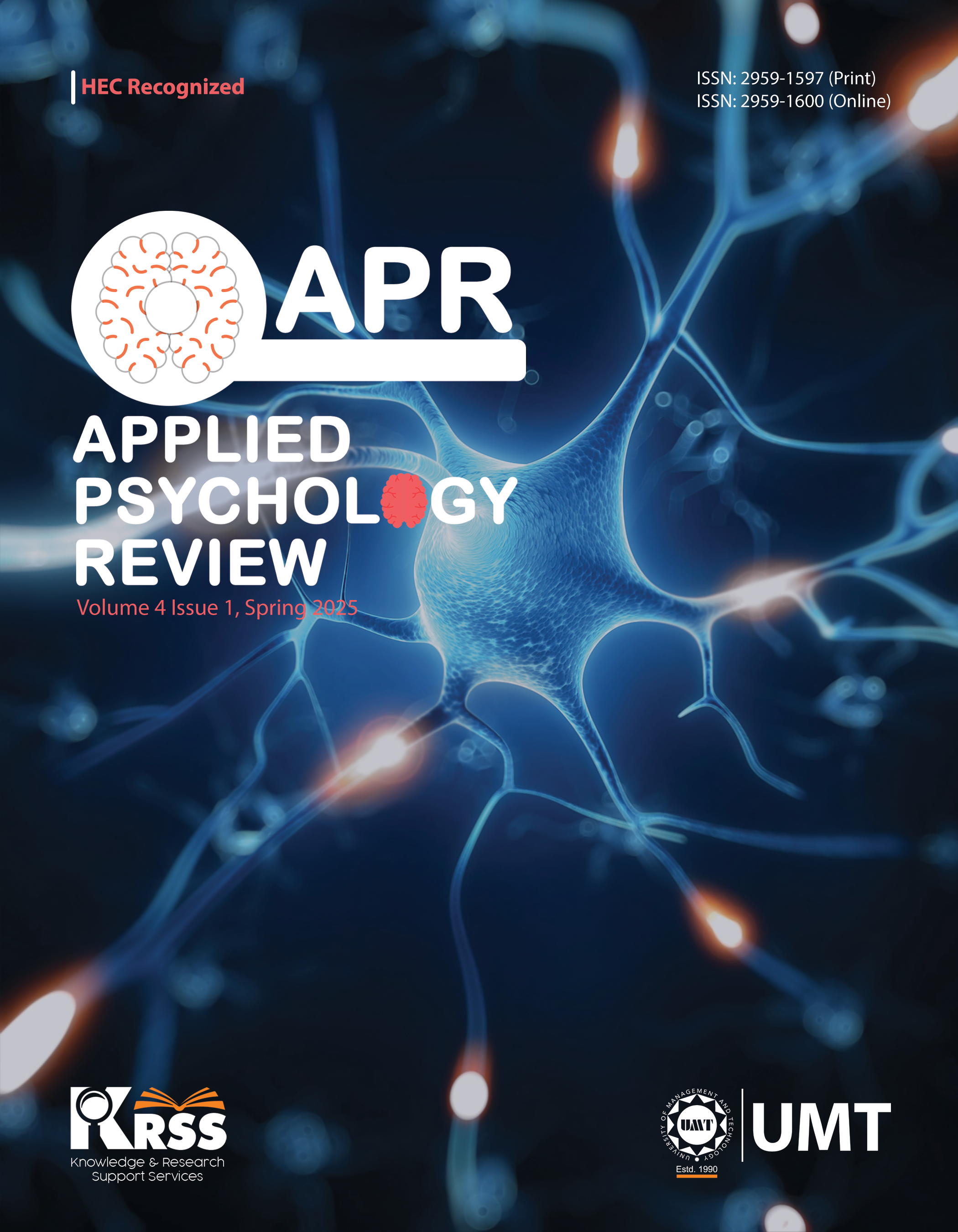Premenstrual Symptoms and Sleep Quality among Pakistani Women: The Mediating Role of Interpersonal Relationships and Moderating Role of Emotional Regulation
Abstract
 Abstract Views: 0
Abstract Views: 0
Research indicates that due to premenstrual symptoms, women experience disturbed interpersonal relationships, adverse emotional regulation, and markedly impaired quality of sleep. The present study aimed to determine the mediating role of interpersonal difficulties and moderating role of emotional regulation between PMS and sleep quality. Urdu translated versions of Premenstrual Syndrome Scale, Emotional Regulation Scale, Interpersonal Difficulties Scale and Pittsburgh Sleep Quality Index were used. Sample size of 115 was selected based on G-Power Analysis. Study found interpersonal difficulties to be partially mediating (β=.02, p<.05) and emotion regulation (suppression) to be moderating (β= -.004, p<.05) between PMS and sleep quality. Furthermore, it was found that the effect of PMS on sleep quality remains significant at lower suppression levels. The study has important implication in understanding the role of psychological factors in improving sleep quality of females experiencing PMS.
Downloads
References
Abay, H., & Kaplan, S. (2019). Current approaches in premenstrual syndrome management. Bezmialem Science, 7(2), 150–156. https://doi.org/10.14235/bas.galenos.2018.2358
Biggs, W. S., & Demuth, R. H. (2011). Premenstrual syndrome and premenstrual dysphoric disorder. American Family Physician, 84(8), 918–924.
Buysse, D. J., Reynolds, C. F., Monk, T. H., Berman, S. R., & Kupfer, D. J. (1989). The Pittsburgh Sleep Quality Index: a new instrument for psychiatric practice and research. Psychiatry Research, 28(2), 193–213. https://doi.org/10.1016/0165-1781(89)90047-4
Cheng, S. H., Shih, C. C., Yang, Y. K., Chen, K. T., Chang, Y. H., & Yang, Y. C. (2013). Factors associated with premenstrual syndrome—A survey of new female university students. The Kaohsiung Journal of Medical Sciences, 29(2), 100–105. https://doi.org/10.1016/j.kjms.2012.08.017
Erbil, N., & Yücesoy, H. (2020). Relationship between premenstrual syndrome and sleep quality among nursing and medical students. Perspectives in Psychiatric Care, 58(2), 448–455. https://doi.org/10.1111/ppc.12628
Ezadi, Z., Ramozi, M., Barati, H., Hosseini, M., Hakimi, S., Mohammady, N., Ozaki, A., Kotera, Y., Kaneda, Y., Ramozi, P., & Bek, B. (2025). Prevalence and associated factors of premenstrual syndrome among female university students of the reproductive age group in Kabul, Afghanistan: A cross-sectional study. Women's Health Reports, 6(1), 403–411. https://doi.org/10.1089/whr.2024.0106
Fiebai, P., Ukueku, A. O., & Ogu, R. (2018). Pre-menstrual syndrome. In O. I. Lutsenko (Ed.), Menstrual cycle (pp. 43–66). IntechOpen.
Farooq, A., & Rana, H. J. (2017). Sensitivity, fatigue, sleep disturbance and quality of life in Migraine Sufferer (Unpublished master thesis). University of Lahore, Pakistan
Freeman, E. W. (2003). Premenstrual syndrome and premenstrual dysphoric disorder: Definitions and diagnosis. Psychoneuroendocrinology, 28, 25–37. https://doi.org/10.1016/s0306-4530(03)00099-4
Ghaffarilaleh, G., Ghaffarilaleh, V., Sanamno, Z., Kamalifard, M., & Alibaf, L. (2019). Effects of yoga on quality of sleep of women with premenstrual syndrome. Alternative Therapies in Health and Medicine, 25(5), 40–47.
Gross, J. J., & John, O. P. (2003). Individual differences in two emotion regulation processes: Implications for affect, relationships, and well-being. Journal of Personality and Social Psychology, 85(2), 348–362. https://doi.org/10.1037/0022-3514.85.2.348
Gümüşsoy, S., Dönmez, S., & Keskin, G. (2021). Investigation of the relationship between premenstrual syndrome, and childhood trauma and mental state in adolescents with premenstrual syndrome. Journal of Pediatric Nursing, 61, Article e65–e71. https://doi.org/10.1016/j.pedn.2021.04.022
Jehan, S., Auguste, E., Hussain, M., Pandi-Perumal, S. R., Brzezinski, A., Gupta, R., Attarian, H., Jean-Louis, G., & McFarlane, S. I. (2016). Sleep and premenstrual syndrome. Journal of Sleep Medicine and Disorders, 3(5), Article e1061.
Kalsoom, U., Sultana, A., Amjad, T. & Bairam, S. (2018). Prevalence of premenstrual syndrome and knowledge assessment regarding its prevention among medical students of a private medical college of Islamabad. Pakistan Armed Forces Medical Journal, 68(1), 159–64.
Karaman, H. I. O., Tanriverdi, G., & Degirmenci, Y. (2012). Subjective sleep quality in premenstrual syndrome. Gynecological Endocrinology, 28(8), 661–664. https://doi.org/10.3109/09513590.2011.650769
Karimiankakolaki, Z., Mahmoodabad, S. S. M., Heidari, F., Gerayllo, S., & Khabiri, F. (2019). The relationship between premenstrual syndrome and women’s marital satisfaction. Journal of Midwifery and Reproductive Health, 7(2), 1630–1635. https://doi.org/10.22038/jmrh.2019.33287.1361
Liu, Q., Wang, Y., van Heck, C. H., & Qiao, W. (2017). Stress reactivity and emotion in premenstrual syndrome. Neuropsychiatric disease and treatment, 13, 1597–1602. https://doi.org/10.2147/NDT.S132001
Meers, J. M., Bower, J. L., & Alfano, C. A. (2020). Poor sleep and emotion dysregulation mediate the association between depressive and premenstrual symptoms in young adult women. Archives of Women's Mental Health, 23(3), 351–359. https://doi.org/10.1007/s00737-019-00984-2
Nexha, A., Caropreso, L., de Azevedo Cardoso, T., Suh, J. S., Tonon, A. C., & Frey, B. N. (2024). Biological rhythms in premenstrual syndrome and premenstrual dysphoric disorder: A systematic review. BMC Women's Health, 24(1), Article e551. https://doi.org/10.1186/s12905-024-03395-3
Padmavathi, M. P., Sankar, D. R., Kokilavani, D. N., Dhanapal, K., & Ashok, B. (2014). Validity and reliability study of Premenstrual Syndrome Scale (PMSS). International Journal of Advances in Nursing Management, 2(1), 4–10. https://doi.org/10.5958/2454-2652
Panahi, F., & Faramarzi, M. (2016). The effects of mindfulness-based cognitive therapy on depression and anxiety in women with premenstrual syndrome. Depression Research and Treatment, 2016, Article e9816481. https://doi.org/10.1155/2016/9816481
Petersen, N., London, E. D., Liang, L., Ghahremani, D. G., Gerards, R., Goldman, L., & Rapkin, A. J. (2016). Emotion regulation in women with premenstrual dysphoric disorder. Archives of Women's Mental Health, 19(5), 891–898. https://doi.org/10.1007/s00737-016-0634-4
Ranjbaran, M., Samani, R. O., Almasi-Hashiani, A., Matourypour, P., & Moini, A. (2017). Prevalence of premenstrual syndrome in Iran: A systematic review and meta-analysis. International Journal of Reproductive BioMedicine, 15(11), 679–686.
Saeed, F., & Rana, H. (2019). Emotional regulation, conflict regulation and quality of life in doctors (Unpublished master thesis). University of Lahore, Pakistan.
Saglam, H. Y., & Basar, F. (2019). The relationship between premenstrual syndrome and anger. Pakistan Journal of Medical Sciences, 35(2), 515–520. https://doi.org/10.12669/pjms.35.2.232
Saleem, S., Ihsan, Z., & Mahmood, Z. (2014). Development of interpersonal difficulties scale for university students. Pakistan Journal of Psychological Research, 29(2), 277–297. https://doi.org/10.1037/t54691-000
Tang, H., Guo, B. & Lang, Y. (2019). Research between sleep quality and interpersonalsensitivity of Chinese college students. Research Square. https://doi.org/10.21203/rs.3.rs-73546/v1
Vafapoor, H., Zakiei, A., Hatamian, P., & Bagheri, A. (2018). Correlation of sleep quality with emotional regulation and repetitive negative thoughts: A casual model in pregnant women. Journal of Kermanshah University of Medical Sciences, 22(3), Article e81747. https://doi.org/10.5812/jkums.81747
Wu, M., Liang, Y., Wang, Q., Zhao, Y., & Zhou, R. (2016). Emotion dysregulation of women with premenstrual syndrome. Scientific Reports, 6(1), 1–10. https://doi.org/10.1038/srep38501
Ye, J., & Ye, X. (2020). Adolescents’ interpersonal relationships, self-consistency, and congruence: Life meaning as a mediator. Social Behavior and Personality: An International Journal, 48(11), 1–11. https://doi.org/10.2224/sbp.9428
Zendehdel, M., & Elyasi, F. (2018). Biopsychosocial etiology of premenstrual syndrome: A narrative review. Journal of Family Medicine and Primary Care, 7(2), 346–356 https://doi.org/10.4103/jfmpc.jfmpc_336_17
Copyright (c) 2025 Maryam Hussain, Hina Rana, Huma Iqbal

This work is licensed under a Creative Commons Attribution 4.0 International License.




